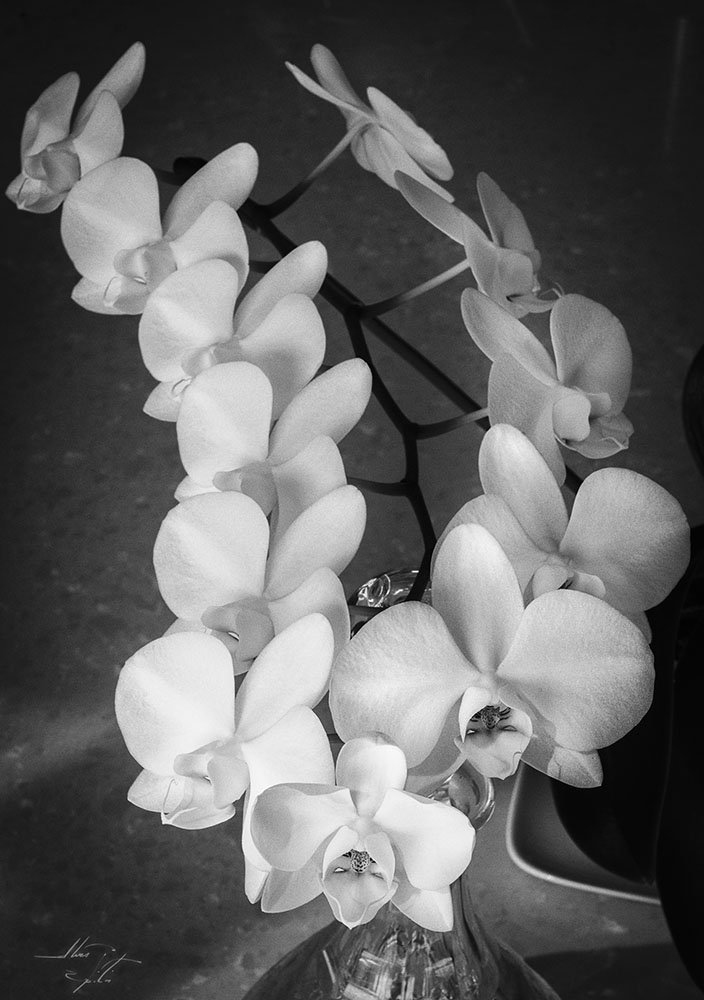Orchidacae
My mother was a Master Gardener. She never saw or grew orchids in her native Latvia. That all changed after our family immigrated to America. When a friend in Upstate New York abandoned her dying orchids to my mom, she went to work with them. Within months the plants began blooming, and my dad proudly called neighbors to see houseplants no one else in town grew.
On every trip I made to Hawai’i, my dad asked me to send my mom a new orchid to add to her collection. At that time only corsage orchids were seen on the mainland. Today, every Costco and Home Depot have large displays of inexpensive orchids for sale. During a trip to Hawai’i my mom marveled at the varieties and lush growth of orchids, even along roadways.
When my mom died, my dad consoled himself with photography, particularly of her orchids and other plants she had nurtured inside the house as well as in her large yard garden. He joked about what a good gardener he was. But he knew the gradual fading of the plants was evidence of his lack of daily care and knowledge.
.
When I moved to Hawai’i, I naively thought her green thumb was genetic. I learned results were not automatic but required research and work. The first fatal mistake I made was to assume orchids needed soil, a sure way to kill them as they are epiphytes and draw water and nutrition from the air. I began tying them to trees and setting them in hanging baskets. A decaying palm trunk provided exceptional nutrition as the roots dug into the decaying cellulose. By happenstance, my most exotic Cattleya orchids flourished there. If only I had a prom to attend.
Orchids grow even in arctic regions but most of us think of them in tropical climates. Growers cross orchids creating ever more exotic colors and shapes. A blue orchid is the holy grail. When a friend called to say he had such a hybrid blooming, I went to photograph it. Chuck shared extra plants from his teeming nursery as did others helping to expand my collection.
Rare blue Coerulea sp. hybrid orchid
The biggest design inspiration came after a stay at the Kahala Hotel on Oahu where I noticed a curved staircase against a lava rock wall with orchids stuck into rock gaps. The floral array was a perfect wedding photo background.
Back home on Hawai’i Island, I had a large lava wall, partly shaded, and already irrigated from above for other plants. I stuffed small orchids into cracks and placed larger ones on flat rocks mortared in as shelves. Decaying wood chips added nutrients to the plant roots. Misting the orchids and occasionally fertilizing them made for constantly changing color accents against the dark lava rock wall. Exceptional blooms were photographed, and I was constantly experimenting with different techniques of scale and lighting. Occasionally, I would clip a flower cluster to enjoy inside my home, but it seemed a shame to shorten its natural life.
Last year my partner’s son gifted her a Phalaenopsis amabilis orchid for Mother’s Day. The flowers had a long life and she clipped off dying blooms as they faded. I recalled a key to the plant flowering again was to leave the long core stem in place letting it naturally deteriorate while continually misting the leaves and roots.
Nearly a year later, a new green stem started growing. Twelve buds eventually appeared and one by one over several weeks all the buds opened. The stem was so long, the blossoms so heavy, that Pat propped the stem up atop a crystal decanter. Later I learned the orchid was known to produce “up to ten flowers on the same stem.” When the last bud opened, it was time for more than an iPhone record.
Ironically this Austin orchid had one notable advantage over its Hawaiian cousin. It was always kept indoors. In Hawai’i it was necessary to photograph the first few blossoms as you’d never have a perfect full cluster. Insects and pests would start degrading the perfect beauty of the first blooms before the last buds opened. But here they were, all open, all perfect and they have been for weeks.
The plant is still rootbound in its original clear plastic pot. When the blooms finally fade, we will transplant it into a larger pot, leaving the flower stem intact, waiting once again a new sprout.
Phalaenopsis amabilis aka Moth Orchid
PS:
When a high school exchange student from Polynesia to Hawai’i was invited to the prom, she was thrilled. But when her date presented her with an orchid corsage, she was disappointed. She was hoping for something rare and exotic to her, like a carnation.

